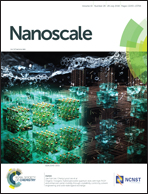Wearable glove sensor for non-invasive organophosphorus pesticide detection based on a double-signal fluorescence strategy†
Abstract
A wearable glove-based sensor has been developed for non-invasive organophosphorus pesticide (OP) monitoring via the fluorescent detection technology. The new “lab-on-a-glove” device integrates a flexible host material (CMC aerogel) and two fluorescent centers (EuMOFs for red and nanosized CDs for blue emissons). After characterizing the performance and stability of the sensor, qualitative and quantitative OP detections are successfully conducted on the surfaces of different agricultural products using swipe collection. The real-time detection system offers considerable advantages such as rapid response (30 s) due to the porous structures of CMC aerogel and MOFs, detection with the naked eye (the red to blue emission transition corresponds to an increase in the OP concentration) and high sensitivity (R2 = 0.99529, LOD = 89 nM) owing to the double-signal sensing strategy in which EuMOFs are the working fluorescence center and CDs are the reference fluorescence center. Compared with other OP detection methods, our strategy of using wearable device with the ratiometric fluorescence method leads to a convenient and reliable detection process for OP analysis. Also, considering its cost advantage, the glove-based sensor holds promise for practical applications in food safety and security.



 Please wait while we load your content...
Please wait while we load your content...